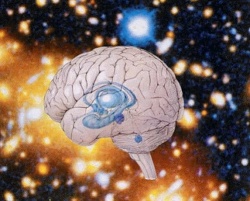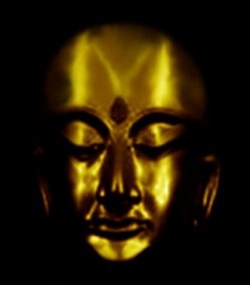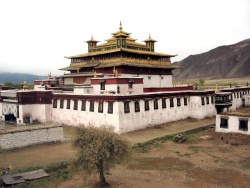Madhyamākalaṃkāra
Madhyamakalamkara (Sanskrit) Madhyamākalaṃkāra (IAST) (8th century CE) is a Buddhist text held to have been originally composed in Sanskrit by Śāntarakṣita (725–788) but extant in Tibetan. The Tibetan text was translated from the Sanskrit by Surendrabodhi (Wylie: lha dbang byang chub) and Yeshe De (Wylie: ye shes sde).
Nature of text
In the short verse text of the Madhyamākalaṃkāra, Śāntarakṣita details his two truths philosophical synthesis of the conventional truth of Yogacara with the ultimate truth of the Madhyamaka with the assistance of Buddhist logic, with a protracted discussion of the argument of "neither one nor many" (gcig du 'bral ba'i gtan tshigs).
Dharmic dialogue
Madhyamākalaṃkāra, is a doxographic reprise in brief, a critical thumbnail-survey of the philosophical History of Buddhism and its inter- and intra-Dharmic dialogue of medieval Islam] belonging to the former and Hinduism (verse: ?), Jainism (verse: ?) and Sikhism (verse: ?) belonging to the latter, evident in India up until his departure from India to Tibet. Though somewhat lyrical, an executive summary and key to his encyclopedic Tattvasamgraha, if you will. Therefore, it contains the fullness of the Sutrayana and Mahayana traditions' development in its place of origin, the status quo in situ, before the Buddhadharma tradition of India was further transposed and acculturated by the various cultures to the Far East (e.g. China, Japan, etc.), east of India, and elsewhere (e.g. Ceylon, Kashmir, etc.), where the Buddhadharma was already evident and for the most part flourishing in culturally specific forms.
It enshrines: refutations to the challenges of various Buddhist systems and tenets from both within the tradition, that is, it is a pedagogical discourse on the developmental iteration of the yana; the philosophical challenges posed by both non-Buddhadharma Dharmic Traditions and the non-Dharmic traditions of India; and crystallizes a dialectical sophistication in the employ of Indian logic and sports the pristine diamond-like clarity of vigorous courtyard debate to be expected of a Khenpo of Nalanda Vihara (khenpo: by station, quality and degree). The text was seminal and formative in the tradition of Samye which came to be known as a Nyingma institution in contradistinction to the emergent Sarma traditions of the latter translation phase heralded by Atisha (980-1054).
Importantly, the text documents the Nyingma view of the Two Truths and as such, is a canonical work, a required text of the Nyingma 'syllabus' (Tibetan: shedra), to be 'studied, contemplated and realized' (Sanskrit: mulaprajna) by senior 'exegetes' (Tibetan: khenpo; Geshe). Historically, the text became marginalized due to the rise of Prasaṅgika Mādhyamaka post-construction of the Prasaṅgika/Svatantrika doxographic dichotomy of Patsap Nyima Drak (1055–1145)... but was again foregrounded by the eloquent Commentary of Ju Mipham (1846–1912) composed in 1876, more than a millennium after the root text's translation to Tibet, translation in the co-denotation of transposition and transportation.
Madhyamākalamkāra and Samye Ling: entwined traditions and historical context

The Madhyamākalaṃkāra and its living tradition inaugurated by Śāntarakṣita, survived the destruction of Nalanda Vihara and the ascendancy of the Moslem Empire in Medieval India during the 13th century eclipse of Buddhism in its place of origin through its fortuitous transplantation to the Indian highlands, the Tibetan Plateau, by Śāntarakṣita in the 8th century at the request of the Dharmaraja Trisong Detsen, where the synthesis of the Madhyamālaṃkāra was institutionalized and taught at the fortified Samye Ling (sited by Śāntarakṣita, its founder who also became its first Kenpo), safeguarded by the Himalaya, its defensive walls and the sacred geometry of the mandala upon which it is founded and the foundation dance of Vajrakilaya performed by Padmasambhava to remove energetic obstructions and obfuscations of its construction and continuity.
Madhyamākalamkāra: an English discourse and literature review
Lipman (1979) opened the discourse of the Madhyamakālaṃkāra into English.
The Madhyamākalaṃkāra and attendant commentary of Ju Mipham (1846–1912) is available in two scholarly English renderings: Doctor (2004) and Padmakara Translation Group (2005). Blumenthal (2004) also provides a rendering of the Madhyamālaṃkāra along with the commentary of Gyaltsab Je (1364–1432). Doctor (2004: p.ix) states that the Madhyamākalaṃkāra:
- ...is renowned as the principal scripture of the Yogācāra madhyamaka. Although masters such as Ārya Vimuktisena (6th century CE) are said to have set forth their presentations of the Madhyamaka in a way that employs the assertions specific to the Vijñānavāda, Śāntarakṣita was the one to found an actual system in which the ultimate freedom from constructs (Skt. niṣprapañca, Tib. spros bral†) is realized through insight into the non-existence of any external matter (bāhyārtha, phyi don‡). This synthesis of Yogācāra and Madhyamaka, the two great currents of Mahāyāna philosophy, the principles of the vast and the profound as originally set forth by Asaṇga (fl. 4th century) and Nāgārjuna (possibly 150-250 CE) respectively, is also characterized by its use of the pramāṇa methods of Dignāga (5th-6th century) and Dharmakīrti (6th-7th century) as integral steps towards the realization of the ultimate.
Annotation key
† = Dharma Dictionary (June, 2006) provides a strong working definition of "spros bral". Source: [1] (accessed: Saturday February 28, 2009)
‡ = Dharma Dictionary (May, 2006) provides a working definition of "phyi_don". Source: [2] (accessed: Saturday February 28, 2009)
Nomenclature, orthography and etymology
Berzin (2006: unpaginated) renders the title in English as "A Filigree of the Middle Way (dBu-ma rgyan, Skt. Madhyamaka-alamkara)".
Logic
‘Indian Logic’ is primarily a study of inference-patterns and ‘inference’ (anumāna; etymology: ‘anu’ subsequent + manas ‘perception, mind’ ) is identified as a ‘source of knowledge’, a pramāṇa. ‘Indian Logic’ should not be understood as logic in the sense of ‘Aristotelian syllogistic’ (Greek or Classical Logic) or ‘modern predicate calculus’ (modern Western Logic), but as anumāna-theory, a system in its own right. ‘Indian Logic’ was influenced by the study of grammar, whereas Greek or Classical Logic which principally informed modern Western Logic was influenced by the study of mathematics. Vidyabhusana (1921), Randle (1930) and Stcherbatsky (1930) employed terms such as “Indian Logic” and “Buddhist Logic” which established this terminology, though a key difference between Western Logic and Indian Logic is that certain epistemological issues are included within Indian Logic; whereas, in modern Western Logic they are deliberately excluded. Indian Logic includes general questions regarding the ‘nature of the derivation of knowledge’, epistemology, from information supplied by evidence, evidence which in turn may be another item of knowledge.
Padmakara Translation Group (2005: p. 157) render Mipham's advice that the following elements of Buddhist logic are required to engage the text:
- In general, it is important to be familiar with the teachings on probative signs and reasoning and, within that context, the notions of other-elimination, the three conditions of the correct sign, and all the methods of proof or refutation.
Apoha: negation of the opposite
According to the doctrine of 'Apoha' (called in Tibetan gshan-sel-wa), an entity is defined as being the negation of its opposite, e.g. a cow is that which is not a not-cow.
Trairūpya: the triple-character of inferential sign
Dignaga formulated the following ‘three conditions’ (Sanskrit: trairūpya; Wylie: tshul-gsum), which, he claimed a logical ‘sign’ or ‘mark’ (linga) must fulfill:
- It should be present in the case or object under consideration, the ‘subject-locus' (pakṣa)
- It should be present in a ‘similar case’ or a homologue (sapakṣa)
- It should not be present in any ‘dissimilar case’ or heterologue (vipakṣa)
When a ‘sign’ or ‘mark’ (linga) is identified, there are three possibilities: the sign may be present in all, some, or none of the sapakṣas. Likewise, the sign may be present in all, some or none of the vipakṣas. To identify a sign, we have to assume that it is present in the pakṣa, however; that is the first condition is already satisfied. Combining these, Dignaga constructed his ‘wheel of reason’ (Sanskrit: Hetucakra).
Exegetical tradition and commentary
Kamalaśīla's Commentary
(Sanskrit: Madhyamālaṃkāra-panjika, Wylie: dbu ma rgyan gyi dka' 'grel)
'Commentary on Difficult Points' (Sanskrit: Madhyamālaṃkāra-panjika, Wylie: dbu ma rgyan gyi dka' 'grel) by Kamalaśīla (flourished 713-763)
Ju Mipham's Commentary
(Wylie: dbu ma rgyan gyi rnam bshad 'jam dbyangs bla ma dgyes pa'i zhal lung)
Ju Mipham's Commentary (Wylie: dbu ma rgyan gyi rnam bshad 'jam dbyangs bla ma dgyes pa'i zhal lung) has been rendered into English by Doctor (2004) as "Speech of Delight". Rigpa Shedra (August, 2008) render the Commentary into English thus: "Words to Delight My Teacher Manjughosha". The title conveys Mipham's samaya in honouring the charge or dictate of his root-guru (rtsa ba'i bla ma), Jamyang Khyentse Wangpo (1820–1892), who bound the mandate of the commentary upon Mipham. Manjughosha is a name of Manjushri, and is employed as term of deep respect for his root guru and bespeaks of the vast learning, scholarship and realized understanding beyond letters and words of this 19th-century Rimé luminary. Suchness, is the revealing of Mipham's Guru Yoga from the colophon, rendered by the Padmakara Translation Group (2005: p. 382):
- Seeing that there are many reasons for expounding the Madhyamakalankara, Jamyang Khyentse Wangpo, our incomparable guide, unbounded in his kindness, whose very name I hardly dare to pronounce, who is the very personification of the compassion of the abbot Bodhisattva, of the master Padmasambhava, and of King Trisong Detsen, who is the sovereign among the learned and accomplished, who is supreme Manjushri appearing in the form of a monk in saffron robes, and whose renown fills the world, gave to me the Indian and Tibetan commentaries on the Madhyamakalankara, asking me to study them well and to compose a commentary. And as his diamond like injunction came down upon my head, I earnestly gave myself to the task.
Ringu Tulku, et al. (2006: pp. 193–194) in their survey of the Rimé movement, convey the importance of Mipham's Commentary to the Nyingmapa and their view of the Two Truths doctrine in light of the 'Svatantrika Madhyamaka' ("those who assert the ultimate is the illusory nature") view and its Shentong Madhyamaka refinement as qualifying the 'Prasangika Madhyamaka' ("those who make no assertions"):
- Then, for the ultimate truth, there are two schools of Madhyamaka: those who assert the ultimate is the illusory nature, and those who make no assertions. To explain further, the first says that the illusory nature is established when the perceiver of an object experiences a perception of that object as being unreal. This view was put forth by Kamalashila, Shantarakshita, and other proponents of the Svatantrika Madhyamaka school. Their view is clearly explained in Mipham Jamyang Gyatso's commentary on Shantarakshita's 'Ornament of the Middle Way.' This commentary by Mipham Rinpoche is often considered the most important philosophical text of the Nyingma lineage in Tibet, particularly for those who follow Mipham Rinpoche's understanding of the Shentong Madhyamaka view.
Gyaltsab Je's commentary
(Wylie: dbu ma rgyan gyi brjed byang)
Gyaltsab Je (1364–1432). dbu ma rgyan gyi brjed byang (Remembering 'The Ornament of the Middle Way').
Tulku Sungrap's commentary
(Wylie: dbu ma rgyan gyi mchan 'grel nyung ngu lta ngan gcod pa'i ral gri)
Lobzang Dongak Chökyi Gyatso (Wylie: blo bzang mdo sngags chos kyi rgya mtsho, 1903–1957), also known as Tulku Sungrap wrote the commentary rendered into English as "The Sword to Cut Through False Views" (Wylie: dbu ma rgyan gyi mchan 'grel nyung ngu lta ngan gcod pa'i ral gri).
'Neither one nor many' (gcig du 'bral ba'i gtan tshigs)
The continuum of the mindstream or 'stream of being' of sentient beings is one application of the argument of "neither one nor many" (gcig du 'bral ba'i gtan tshigs). 'Neither one nor many' is an application of the third function of the Catuṣkoti of Indian Logic (and thereby according to apoha, the fourth function as well). As Hopkins, et al. (1983, 1996: p. 160), convey in their magnum opus in refutation of whether or not a 'series' may be considered a 'unit'
Mindstream
Śāntarakṣita, in the ninth shloka of the Madhyamālaṃkāra, refutes the true singularity of the person, where 'person' instead is conveyed as a continuum, though technically understood to be "neither one nor many". Padmakara Translation Group provide a salient qualification of the term 'person' (Wylie: gang zag), extending it to all sentient beings of the Bhavacakra.
Following is the same shloka, Madhyamālaṃkāra 9, rendered by Padmakara Translation Group (2005: p. 180) on bottom left and Doctor (2004: p. 219) bottom right:
Ju Mipham is commenting on this root verse is rendered as follows, first by the Padmakara Translation Group (2005: p. 180) bottom left; and second, by Doctor (2004: p. 219) bottom right:
|
|
Five assertions
In addition and related to that, according to Ju Mipham, he made five assertions while not unique to Śāntarakṣita's view individually uncommonly integrated nonetheless:
- Objects — which is to say fully qualified objects of comprehension — are posited only with respect to things that are able to perform functions.
- The way he asserts cognition or consciousness in the absence of an object — that knows itself and illuminates itself — is uncommon.
- The various appearances of the external appear through or due to the power of one's own mind. Due to which they are asserted as mind-only.
- The ultimate is divided into the enumerated ultimate and the non-enumerated ultimate.
- On the occasion of settling the enumerated ultimate, the objects found by the individual valid cognitions are apprehended without contradiction.
First assertion
In the first, Śāntarakṣita uses the Sautrantika distinction that objects of cognition can be of two kinds: abstract mental objects which are merely theoretical - including generalities like classes of objects and labels for them - and then objects of cognition of actual things. To define actual things he says things that can perform some sort of function. The Sautantrika used that distinction for conventional and ultimate truth, but Śāntarakṣita discards the merely theoretical or generality objects completely and then discusses the objects of cognition of actual things as conventional truth. Further, he incorporates Dharmakirti's valid cognition that analyzes conventionalities but also connects that with valid cognition that analyzes for ultimacy.
Second assertion
In the second, he asserts that a self-reflexive awareness(Svasaṃvedana) exists conventionally. That is to say, that consciousness can be aware of the objects of cognition. This position was later critiqued by Je Tsongkhapa as implying that a self-reflexive awareness is an existent, separate thing from the objects of cognition. Ju Mipham later qualified the meaning to be that within conventions we can say that all cognition is self-aware of itself and not a separate material thing.
Third assertion
In the third, he uses the consciousness-only view as the way a student may relate to conventional appearances in post-meditation as the best way to progress along the path. He still affirms the supremacy of the Madhyamaka school when students analyze for ultimacy, but generally when relating to conventionalities he asserts that a mind-only position is recommended.
Fourth assertion
In the fourth, he makes a distinction between the ultimate way of abiding — established by the method of the Madhyamaka — which he calls the non-enumerated ultimate and an approximate or enumerated ultimate that is a lesser conventional understanding of the ultimate yet which leads one closer to the non-enumerated ultimate.
As part of his reasoning for why this is useful, Mipham quotes Gorampa, who references the 'four conceptual extremes' (Wylie: mtha' bzhi; Sanskrit: caturanta):
- The intellect of ordinary people, which investigates ultimate reality, cannot refute in a single stroke all four conceptual extremes. But by refuting these four extremes one after the other and by meditating properly, one reaches the path of seeing. This is called the view that sees the dharmadatu.
So in terms of analyzing the extremes of existence and non-existence, he suggests students first contemplate the lack of inherent existence and establish this first. Then after that contemplate the extreme of non-existence. In contemplating step by step and enumerating through the conceptual extremes a student does not realize the ultimate truth but moves in a progressive manner toward the ultimate. Once all extremes have been analyzed then the student finally arrives at the non-enumerative or true ultimate.
Fifth assertion
In the fifth, he further asserts that analysis of objects with respect to those approximate or enumerated ultimates does not create a problem of true establishment. In part, he does this by noting that a clear distinction can be made when one is analyzing for each case, including the use of two different approaches of valid cognition — one for the conventional domain and one used for analyzing for ultimacy — which is his addition to the Pramana tradition of valid cognition. Mipham uses this demonstration in his commentary to point out a problem with Je Tsongkhapa's approach of negating the predicate of 'true establishment' instead of negating the object of perception altogether, which is avoided in Śāntarakṣita's approach. And Mipham also notes that many of the supposed Prasangika writers had — similar to Svatantrika writers — previously made positive assertions in order to move students closer to the ultimate view, pointing out that the distinction between Prasangika and Svatantrika is really one of how one talks to students about conventionalities and not really a distinction of how one considers ultimate truth. Further Mipham concludes that Je Tsongkhapa by making a distinction of true establishment is also proposing a Svatantrika approach instead of a truly Prasangika approach.





